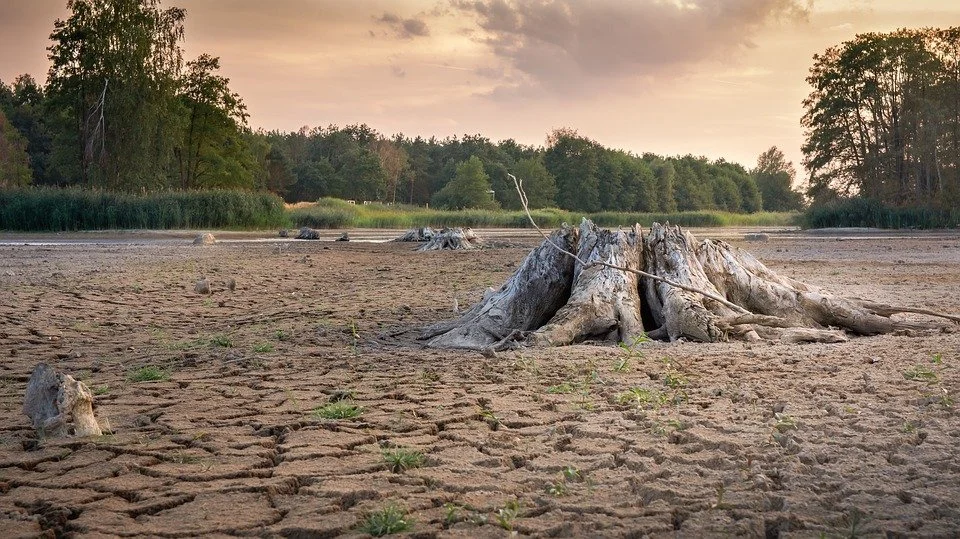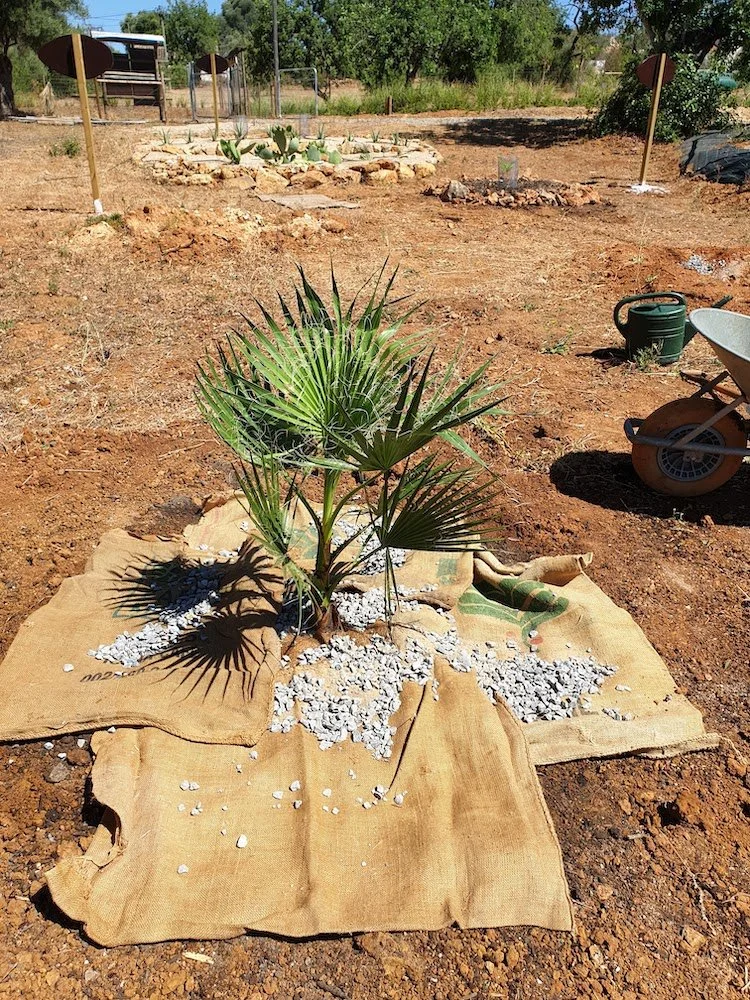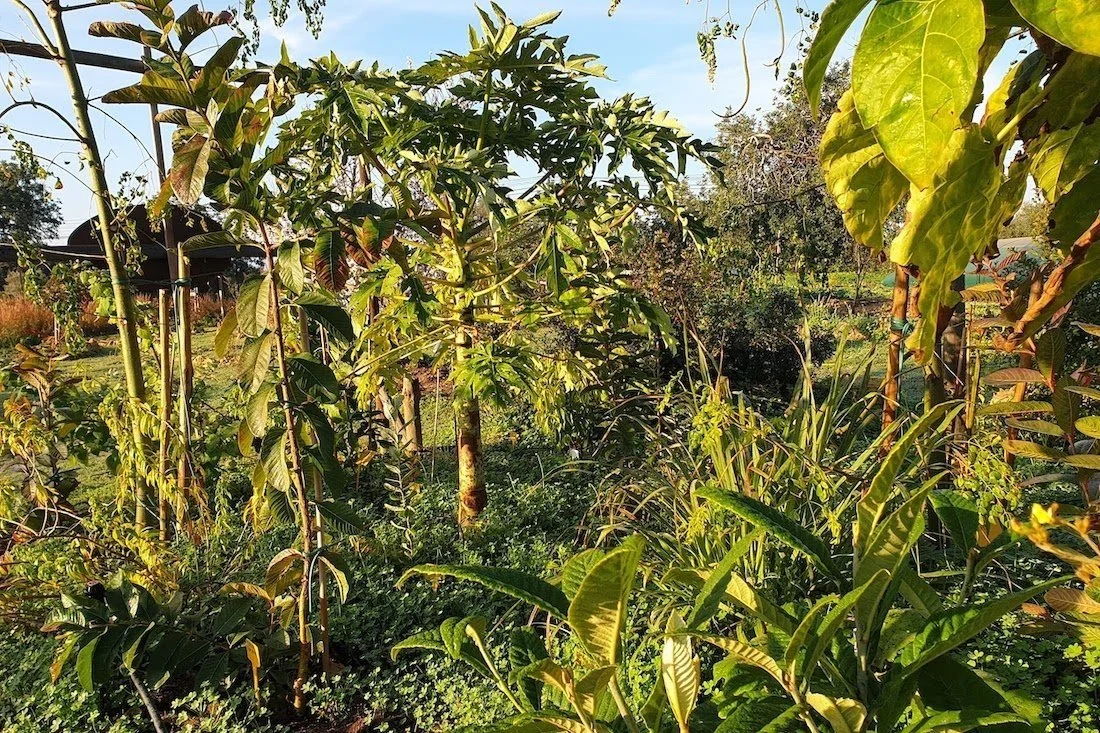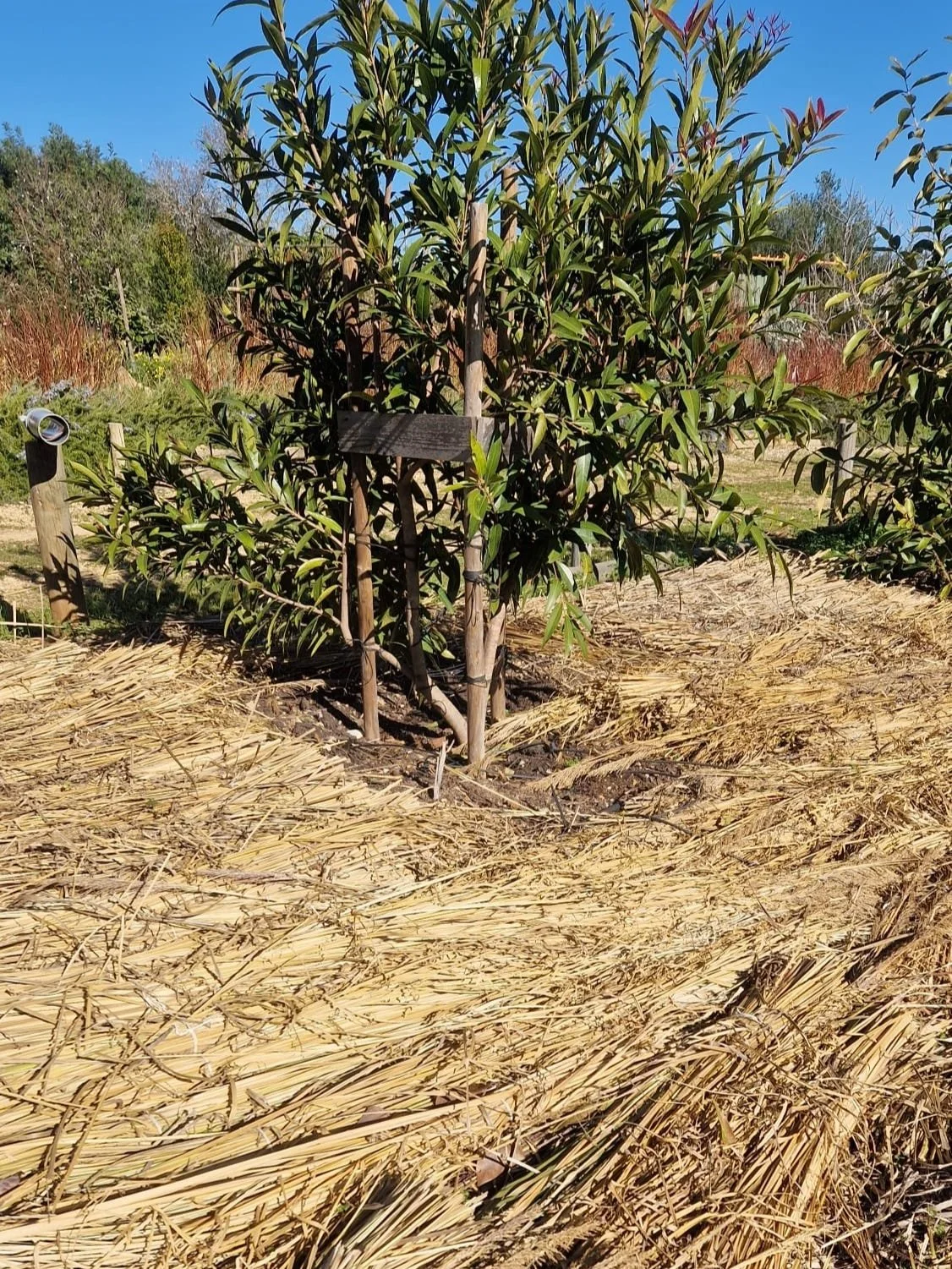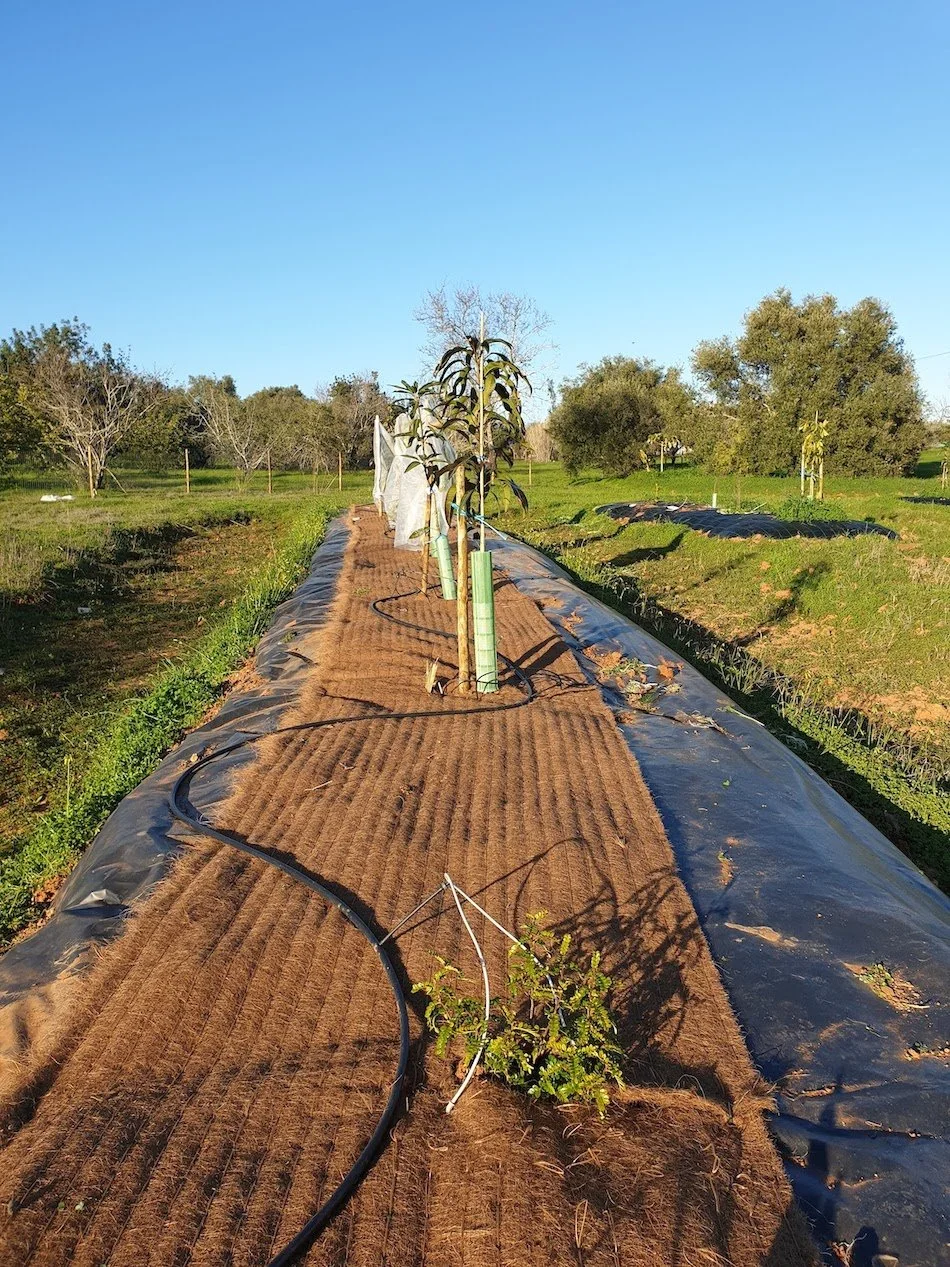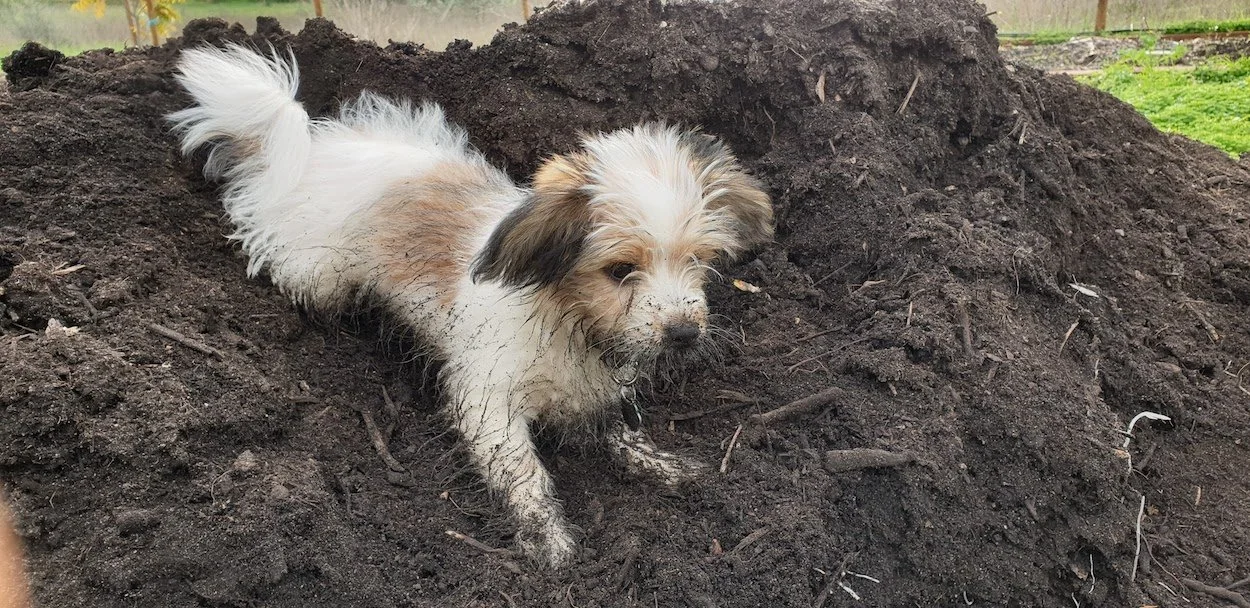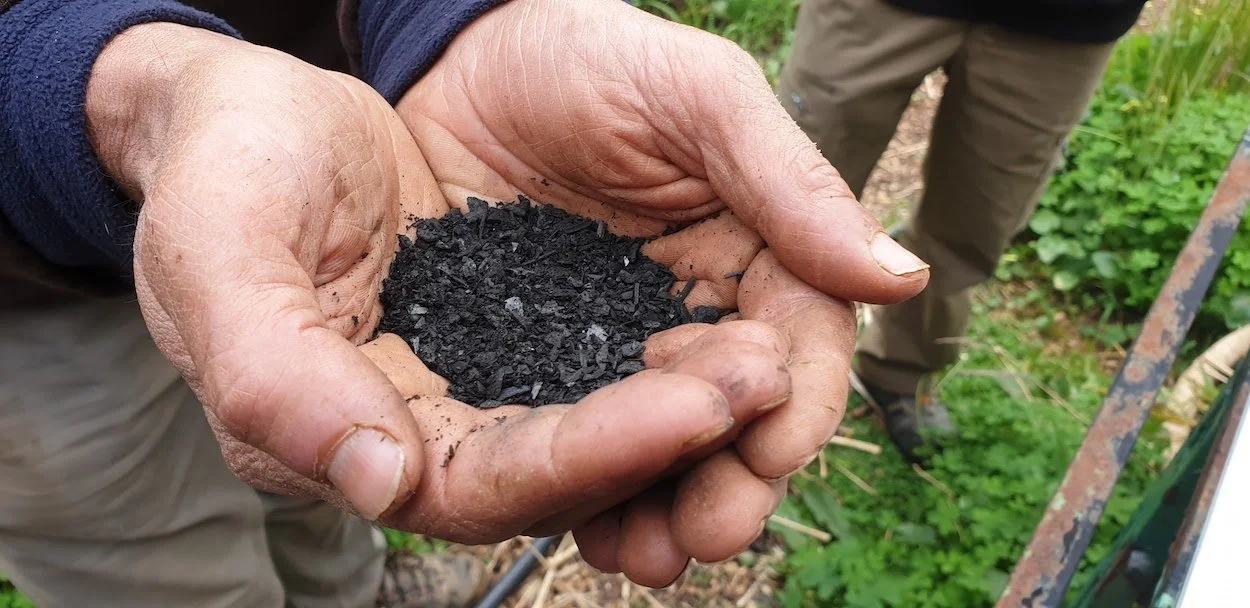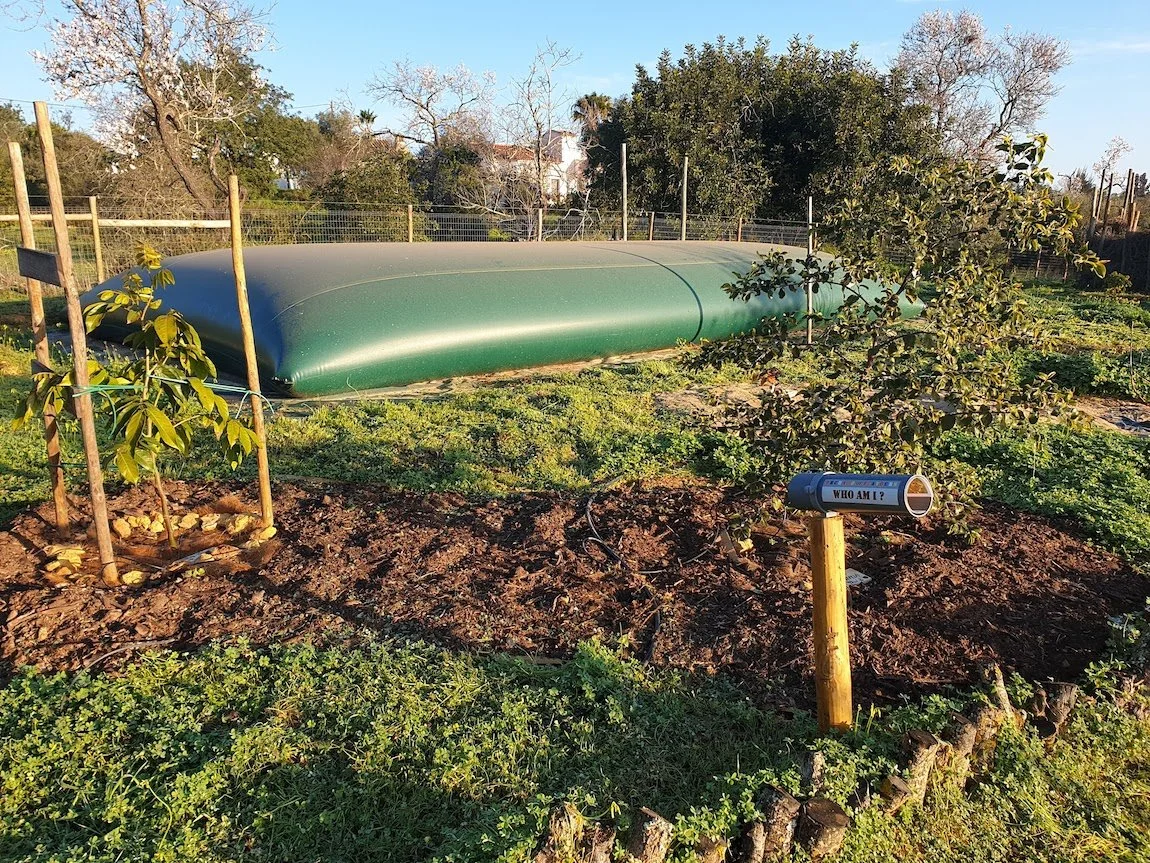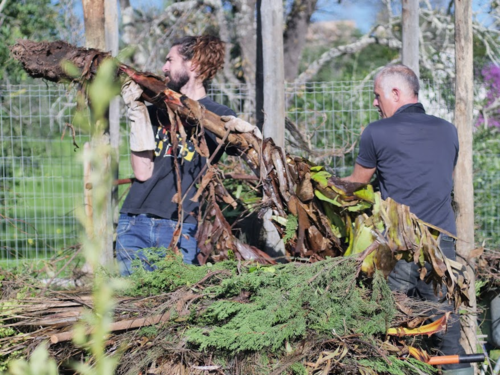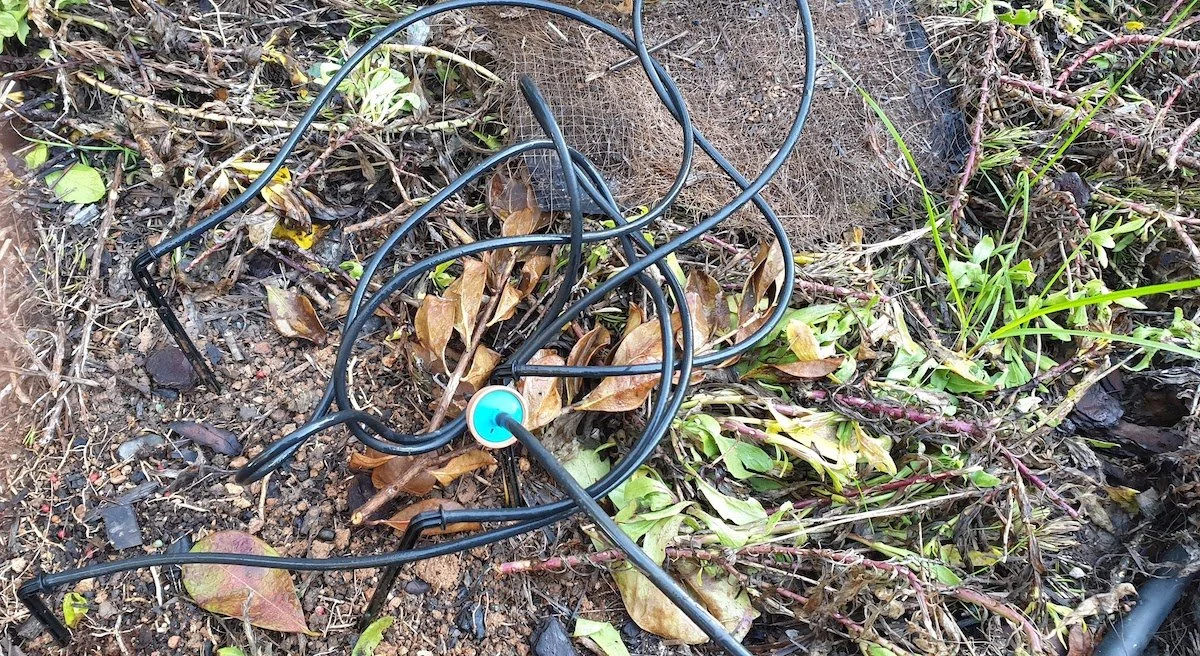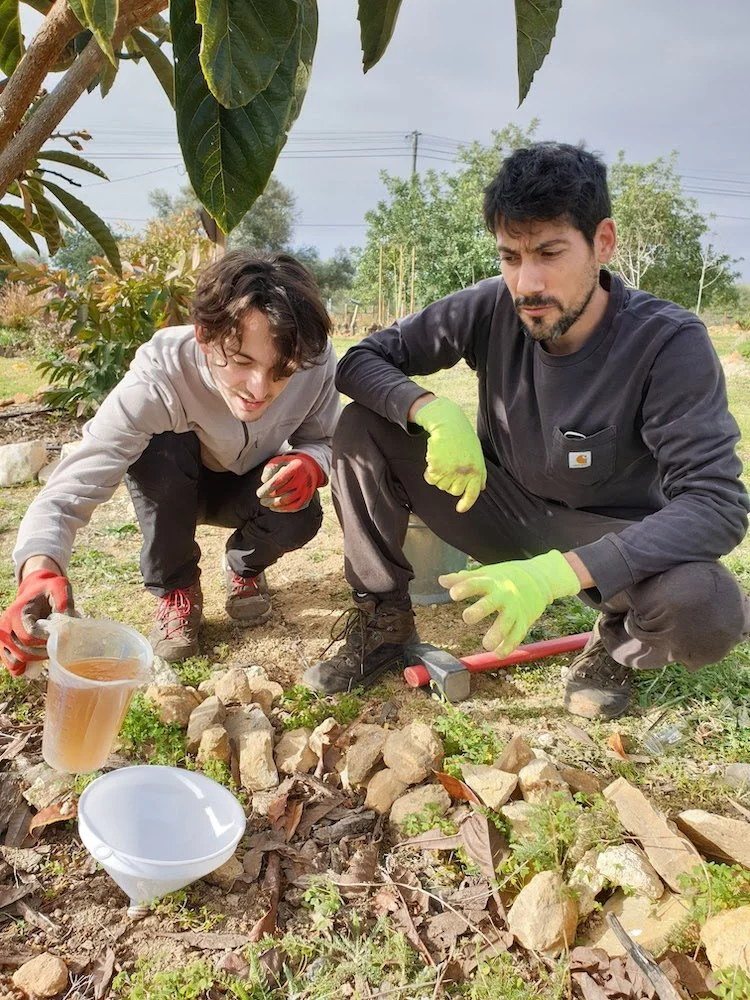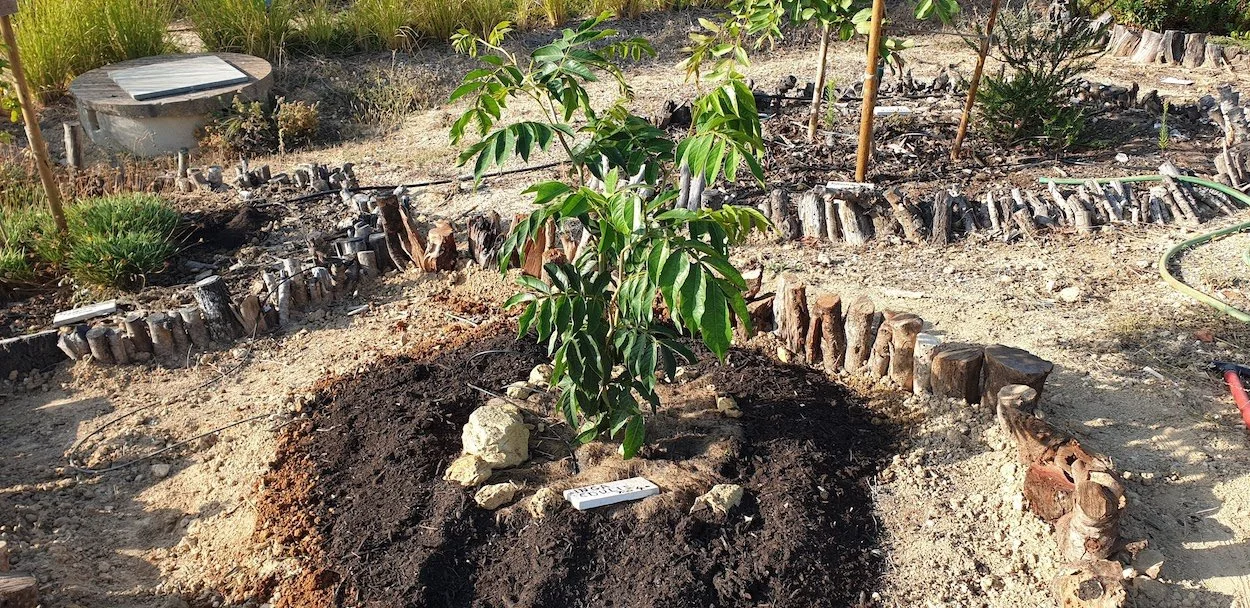Drought emergency plan
With an average annual rainfall of less than 500mm, southeast of Portugal is one of the driest areas in Europe. Usually, rainfall in the region is limited to the winter months, with long dry summers, as it is typical for a Mediterranean climate. Most of the plants adapted to this climate can handle this situation.
In recent years, however, long periods of drought have become more frequent and water is now becoming a scarce commodity. Our climate is changing.
This new and hugely challenging context brings about new questions. How can you help the plants in your orchard/food forest face droughts? How can you make your garden/property drought-proof?
Keep reading to find some tips and guidelines to practises we’ve been experimenting and refining while working here at our Orchard of Flavours, in preparation for future (and present) adversities.
A. Plant drought tolerant and/or drought resistant varieties
Having a drought resistant orchard can start with selecting the right varieties. Read our article about drought tolerant or drought resistant plants to find out more about these kinds of plants, and the species/varieties we have in the Orchard.
B. Plant densely
When Trees and shrubs are planted densely, they shade the ground much more effectively and drop their own mulch right where it’s needed. Shade greatly decreases temperatures beneath the canopy and mulch reduces evaporation from the soil. Denser planting also slows air circulation. All of these factors help conserve moisture and the plant’s watering needs are lower than if they were planted apart.
Read our articles about the Miyawaki forest method to learn more about the strengths that higher density and diversity of planting can bring to your living system.
C. Save as much soil moisture as possible and avoid evaporation
1 - Mulching
The most important way to keep the soil moist and alive as well is mulching. At Orchard of Flavours, we apply many different mulching techniques, and the options are really only limited by your imagination.
You can mulch with organic materials like leaves, woodchips, straw, vetiver grass (see picture) coco coir, cardboard,... Mulches made from organic materials hold moisture, and they gently release nutrients into the soil. These kinds of mulches tend to promote microbial and fungal activity and improve soil structure, making it less prone to erosion, crusting or compaction, and also better at holding moisture.
If you decide to use organic mulches around trees, don't apply them too close to the trunk as this might cause fungal infection. Leave a minimum of 20 cm free of mulch around the trunk.
All mulches behave differently and some have additional advantages and disadvantages so if you are interested you can check out our article about mulching techniques.
Another benefit of mulching is less to no weeds! Success will of course depend on the density/thickness of your mulching material and how fast it breaks down. Using ‘bioplastic' or well laid out cardboard, for instance, suppresses most weeds for at least the first year.
In case of severe drought, note that geo-textile (made of plastic) is more efficient than wood chips at preventing evaporation.
2 - Weeding
The importance of weeding around newly planted trees cannot be understated. There is lots of scientific research about it.
Weeds compete for light, nutrients and, most importantly, available water in the soil. Without systematic weeding, young trees can suffer poor growth rates and in some cases die. As a rule of thumb, three years of weeding should ensure successful tree establishment. Thereafter, although competition may still reduce tree growth, weeding may no longer be cost-effective in an operation.
3 - Adding compost and biochar
It is extremely helpful to add compost to your soil and work it in with a garden fork or a small shovel. By increasing the organic matter in your soil, you increase its ability to hold water.
Proven to enhance the soil’s capacity to hold moisture, as well as nutrients and microbiology, biochar is an invaluable soil amendment and another precious tool when tackling drought. You can check our Learn article on biochar for more about its uses and strengths.
4 - Creating shades and windbreaks
Fast growing canopy trees help create shade in your garden, allowing for lower temperatures and the resulting lower evaporation rates. At Orchard of Flavours, we are experimenting with two fast-growing canopy trees: Inga edulis (Ice cream bean tree) and Carya illinoinensis (Pecan tree).
Windbreaks are another important tool for decreasing evaporation. You can read more about windbreaks in our article.
5 - Spray a natural sunblock on the leaves
Kaolin clay sprays, accepted in organic farming, are ever more used as a natural sunblock that can be sprayed on leaves in order to protect trees from sunburn and high temperatures. It is also an important organic strategy in orchards, used after petal fall, in order to repel many types of pest insects. The white clay particles remain on the surface of the leaves and keep the tree cool so that photosynthesis can continue longer into hotter hours of the day, after untreated trees have already shut down because of heat stress.
6 - Water retention products
There is increasing research on water retention products which can hold water at the root level and slowly release it. Often referred to as “solid water” or “hydrogel”, these solutions are seen as a great tool to save water (in some cases, up to 50%) and to increase success when planting in sandy soils. They are already widely used in many arid regions, in countries like Saudi Arabia.
Most currently available products are made of polymers (polyacrylamide) and can hold up to 500% their initial size. In Europe, their use is not allowed in growing edible plants because it’s believed their decomposition could release toxic acrylic acid, though the industry says it is completely biodegredable. In many non-EU countries, it is widely used even in growing vegetables and in organic farming. CAPT Super HydroRetenteur and STOCKOSORB 660 are two of the existing options.
Further research is being made to develop hydrogels composed of natural and biodegradable materials that would allow for applications in agriculture without the potential risks of synthetic hydrogels. Some of those products are organic certified and are usually made from seaweed, wood or minerals. Agrobiogel, AGRI-OSMOZ and Fasal Amrit are examples of these.
D. Harvest and store water
Many techniques can be applied to harvest rainwater from hard surfaces such as roofs or terraces and have it stored in tanks, flexible cisterns, ponds or lakes. Please keep in mind that an open-air water storage, using ponds or lakes, while also having beneficial side effects — attracting wildlife and being used for swimming and leisure — is maybe not the best solution in drought-prone areas, because a lot of water evaporates when it is exposed to sun and air movement. At the Orchard of Flavours, we decided on a 50-cubic-meter flexible cistern. It is very cost-efficient and the water is kept pure and clean.
Other really important techniques to harvest rainwater should actually be part of the initial design of any garden, orchard or farm. We’re talking about the correct application of swales, keylines, or any other water-harvesting earthworks. Their main goal is simply to slow and spread as much as possible of that precious water that enters your land, and to retain it in the landscape after rain events. This is simply a matter of encouraging it to infiltrate where it is most needed instead of allowing it to run off into neighbouring properties and even worse, eroding your precious topsoil.
E. Irrigate wisely
1 - Springtime — growing time — is crucial
Fruit trees develop most of their leaves and shoots before summer. This growth is important for next year’s crop development. Minimising drought stress early in the season with irrigation water is the least disruptive to fruit trees. Water stress later in the season (summer and fall) has little effect on flowering or fruit set the following year.
2 - Use drip irrigation
Putting in a drip system reduces evaporative losses and can increase irrigation efficiency by about 20% compared to sprinklers which spray water into the air. If you do use sprinklers, run them in the evening.
3 - Design your system with many sectors and many taps!
Having many irrigation sectors gives you more flexibility and allows you to program different frequencies. For example one sector for your succulents which only need water every few weeks and one sector for the fruit trees which needs to be watered more frequently.
Even if you have many irrigation sectors, one sector may include only a few high priority plants that need extra irrigation., In this case it makes sense to install a tap so you can close the irrigation line and water those few priority plants by hand. At Orchard of Flavours, we are also experimenting with “mini taps” on each micro tube irrigating a non essential plant.
4 - Water the entire root system
Water beyond the tree’s drip-line to reach the full expanse of the roots. Infrequent long and slow soaking at the outer edge of the drip line (the area shadowed by the tree crown) is better than frequent short doses of water.
5 - Irrigate deeply
The old adage of watering down deep provides little or no benefit to the plants if there are no roots that deep, then that water is just wasted – a horrible mistake in a drought year.
However, deep irrigation is especially useful if the root system is a taproot.
At Orchard of Flavours, we are experimenting with a cheap eco-friendly technique to irrigate deeply. With an auger , we make a 10cm diameter hole, 60 cm deep. We fill it with unsalty coarse sand and we put a dripper on top of this column of sand.
Because sand is more permeable to water than our high clay soil, the water reaches the roots (faster) and less water is needed. This technique only makes sense in clay soils because clay is quite compact and we expect the sand column to remain intact for a long period of time. If your soil is very sandy, its high porosity renders this deep irrigation system useless.
F. Enhance your plants autonomy/health
We are very hopeful that our use of biostimulants will improve plant resilience in our water-limited environment. Generally speaking, biostimulants can enhance root rather than shoot growth, and this would allow plants to penetrate deeper soil layers during the drought season.
These biostimulants include the introduction of mycorrhizal fungi into the root zone. These can play a huge role in helping plants absorb nutrients and water. The introduction of certain types of rhizobacteria can have a similar effect.
Moreover, a mineral biostimulant, monosilicic acid, is being studied for its role in helping the plant overcome stress factors like heat and drought.
You can find more about our use of biostimulants in our detailed Learn article.
G. Force majeure actions
Imagine that there is no water left to irrigate with. When desperate times come, what can you still do?
1 - Reduce crop load: fruit thinning
During drought, it is useful to reduce crop load early and by more than usual. Plan for aggressive blossom thinning and early fruit thinning. Also be prepared to sacrifice some yield to achieve the desired fruit quality and average size. The good news is: fruit thinning will usually also improve the size of the remaining fruit.
2 - Branch pruning in summertime
Some water can also be saved by pruning during the summer. This means thinning out and topping branches when they have leaves on them. This reduces the total leaf area and therefore reduces the plants’ water use too.
Historically, most temperate fruit trees are pruned in winter. The plants typically respond with strong growth in the spring, which creates a high demand for water and nutrients in the early part of the growing season. Conversely, summer pruning will suppress vigour and reduce the total leaf area, resulting in more efficient use of available water and nutrient resources to help support satisfactory tree growth or survival.
3 - Be ready to treat more pests
A side effect of drought is the onslaught of pests and diseases, including boring insects and fungal pathogens. Stressed trees go through chemical changes that attract opportunistic pests. A tree weakened by drought becomes an easy target for infestation and pathogens.
4 - Don’t fertilise
Fertilising during signs of drought stress can damage roots. Don't fertilise during a drought.
5 - Priority to the young !
Prioritise watering young or new trees and pray for the others !
Find more of our articles regarding this important subject on our Irrigation and Water Saving section.
This article was compiled by Miguel COTTON, Miguel PEREIRA & Christoph LANGER. If you have any questions or suggestions, do not hesitate to contact us. miguel@orchardofflavours.com

